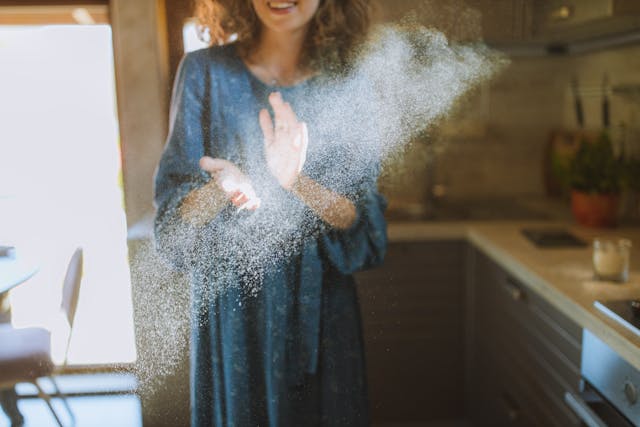
Is household dust made of dead skin? There is a myth that household dust is made entirely of dead skin cells. It is true that sometimes as much as half of household dust is dead skin, but there are many other things in it as well, depending on where you live and your house.
We do lose a lot of skin. That is true. Our skin constantly grows and regenerates throughout our lives. It starts to grow in the lower layers of the epidermis, and the cells there multiply very rapidly. The new skin pushes the layers above it up and is, in turn, pushed up as more skin grows beneath it. As the skin cells get to the outer layer of the epidermis, they die. Their job is to protect our bodies from injury and from invaders such as bacteria. The skin gets cut, damaged, and things get stuck in it. To get rid of these things and to bring up the fresh, undamaged skin from below, the dead outer layer peels off. Depending on how big you are, we lose about 00.3 g to 00.9 g of dead skin an hour. That adds up to about 35 kg over an average human life.
So, we do lose a lot of skin every day, and if there are a lot of people living in the same house, the amount of skin floating around can be higher, but dust is made up of so many other things. We know what dust is mostly made up of thanks to a 2011 study by Canadian scientists. They collected samples of dust from 1025 randomly selected urban households across the whole country and then published their findings. The fact that they chose urban households makes a big difference in what they find because 40% of all the dust in your house comes from outside. If you live in the countryside, that dust from outside is going to be made up of completely different things to people that live in towns. And houses in Canada are going to have different particles in their dust to a house in somewhere like Yemen.
The Canadian study showed that human skin can make up as much as 50% of dust, but it is often much closer to 20%. We do lose a lot of skin, but that doesn’t mean it will automatically become dust. We scrub a fair amount of it off when we are in the bath or shower and that goes down the drain. We lose a lot of it outside and an awful lot of it gets stuck in our clothes and goes down the drain when we use the washing machine. The rest of the dust can be made up of a whole range of particles. You will have paint, construction materials such as dry wall or cement, clothing fibers, particles off your pets, food, pollen, bits of insects, dust mites, fungal spores, hair, and a whole host of other things. Then there are the things that come from outside. There will be pollution from roads and traffic, ash, micro-plastics, salt, soil, sand, and so many other things. Every house you sampled would have a different makeup of dust.
Most of the time, you can’t really see the dust, unless it happens to get caught in the sun. Because the particles are so small, it takes a while before enough dust builds up for you to see. Dust particles are between 1 and 400 micrometers in size. Most of us are fine breathing in the dust in our houses, but it can be dangerous for people with respiratory problems. Some particles can be more dangerous and there are occasionally warnings if these particles are in the air. Some developing countries have a lot of problems with these particles.
The dust particles in our houses are so small that they can float around on the air, but they always tend to settle. They get carried to the ground by the air current, but also by humidity. If the air is humid, it can weigh the particles down and they will sink to the floor. They are also attracted by static electricity. You will know this if you have ever tried to get the dust off a TV screen. This happens because the charge in the dust particles and the charge in your TV screen are opposites and they attract each other. The only way to clean it is with a charged cloth that can attract the particles away from the screen.
It is possible to make a dust free room, and there are often clean rooms in places like microchip factories. However, it is very hard to do. Making the room dust free in the beginning is relatively simple because you just have to suck all the dust out. Keeping it that way is incredibly hard. Everything that goes into that room has to be dust free and incapable of producing dust. And this is what I learned today.
Sources
https://oizom.com/dust-particle-sizes
https://en.wikipedia.org/wiki/Dust
https://www.livescience.com/32337-is-house-dust-mostly-dead-skin.html
https://www.sciencefocus.com/the-human-body/how-much-skin-does-a-human-shed-in-their-life
https://my.clevelandclinic.org/health/body/10978-skin
https://renude.co/blog/skin/the-skin-cycle-explained-97
Photo by Anastasia Shuraeva: https://www.pexels.com/photo/woman-in-blue-long-sleeve-dress-clapping-4122915/
